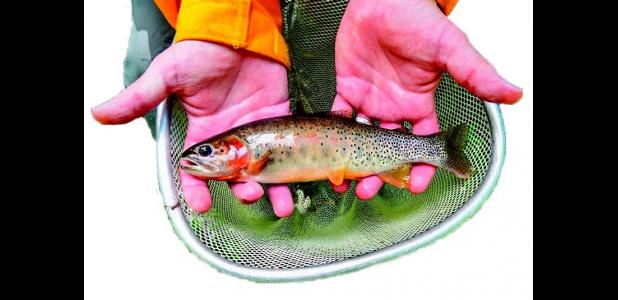Hatchery extends lifeline to rescued cutthroat trout
By Alan Wartes
Ordinarily when a wildfire threatens a landscape, little can be done to protect the wildlife in its path. Limiting the scope of the damage is usually the only option.
However, when a lightning strike on July 8, 2016 sparked a fire in the Hayden Creek and Big Cottonwood Creek drainages southwest of Cañon City, Colorado Parks and Wildlife (CPW) biologists knew they had an opportunity — and an obligation — to do more than watch.
As the fire quickly spread, CPW and U.S. Forest Service personnel mounted an operation behind the fire line to rescue greenback cutthroat trout from the South Prong of Hayden Creek. Fewer than 200 individuals — or about 10 percent of the total — were taken out of harm’s way.
Of those, 36 were released into another drainage — and 158 ended up in the care of biologists at the Roaring Judy Hatchery north of Almont. A survey of Hayden Creek last fall, following intense monsoon rains after the fire, failed to locate a single remaining fish out of several hundred left behind.
In June of this year, staff at Roaring Judy began painstakingly spawning the survivors, with the goal of eventually returning them to the wild. The greenback cutthroat trout is listed as threatened under the federal Endangered Species Act.
“Predicting the timing of the spawn is one of the tricky things about working with a relocated species of fish,” said Seth Firestone, Roaring Judy manager. “Trout use things like temperature cues in the creek and day length to begin the spawn. All of that can impact when they spawn. We had to watch pretty closely.”
Before the disaster, Hayden Creek was home to one of the few remaining pure populations of native greenback cutthroat trout in the state. In fact, even among cutthroats, the Hayden Creek population is unique. They are the only known fish in the world to match the genetics of specimens collected by early explorers in Colorado.
In 1889, ichthyologist David Starr Jordan caught two trout from Twin Lakes near Leadville and preserved them for study. Today, the remains are housed at the Smithsonian Institute’s National Museum of Natural History.
“The fish in South Prong of Hayden have genetic markers that match the museum specimens,” said Josh Nehring, CPW senior aquatic biologist. “We don’t yet have a good handle on exactly what that means, other than we need to preserve them.”
For more than a year, Firestone and his staff have held their Hayden Creek guests in an isolation trailer, to prevent them from breeding with non-native species at the hatchery. Step one was to simply keep them alive by replicating natural conditions to the greatest possible extent.
Initially, that meant feeding them nightcrawlers and blood worms before gradually introducing artificial foods. Water is pumped directly from wells to ensure it is free of contaminants and disease.
“It’s amazing what these guys do,” said Nehring of hatchery staff.
According to Nehring, the goal within five years is to use the spawned fish to establish three to five new populations in diverse locations across the state. First, however, those drainages have to be prepared to receive the trout.
(Alan Wartes can be contacted at 970,641.1414 or alan@gunnisontimes.com.)


